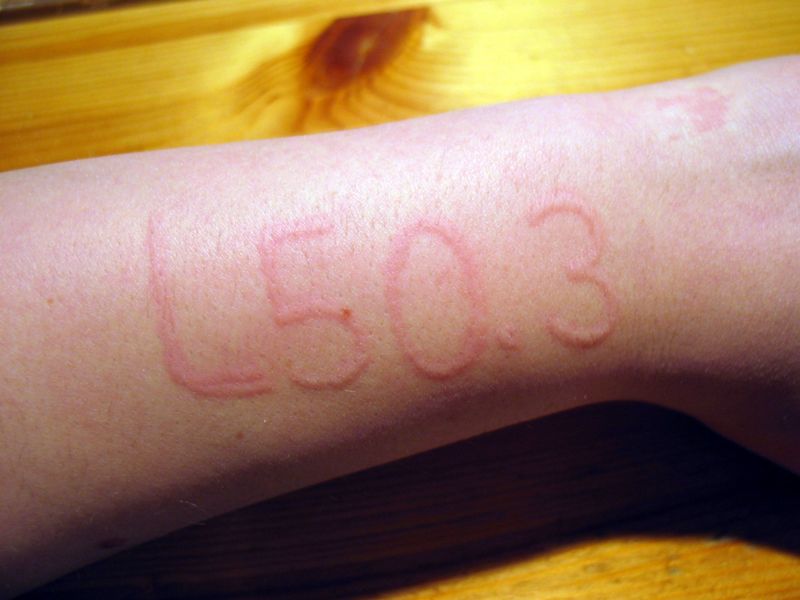Dermatographic urticaria
| Dermatographic urticaria | |
 | |
|---|---|
| Dermatographic urticaria is sometimes called "skin writing". | |
| ICD-10 | L50.3 |
| ICD-9 | 708.3 |
| OMIM | 125635 |
| DiseasesDB | 12736 |
| eMedicine | derm/446 |
Editor-In-Chief: C. Michael Gibson, M.S., M.D. [1];Associate Editor(s)-in-Chief: Kiran Singh, M.D. [2]
Overview
Dermatographic urticaria (also known as dermographism, dermatographism or "skin writing") is a skin disorder seen in 4-5% of the population[1], in which the skin becomes raised and inflamed when stroked or rubbed with a dull object[2]. The symptoms are thought to be caused by mast cells in the surface of the skin releasing histamines without the presence of antigens, due to the presence of a weak membrane surrounding the mast cells. The histamines released cause the skin to swell in the affected areas.
This weak membrane easily and rapidly breaks down under physical pressure causing an allergic-like reaction, generally a red welt to appear on the skin. It can often be confused with an allergic reaction to the object causing a scratch, when in fact it is the act of being scratched that causes a welt to appear. These welts are a subset of hives that appear within minutes, accompanied by a sensation of burning, and/or itchiness. The first outbreak of hives can lead to others on body parts not directly stimulated, scraped or scratched. In a normal case the swelling has reduced itself with no treatment within 15-30 minutes, but in extreme cases, itchy red wheals may last anwhere from a few hours to days.
Dermatographism can be caused by stress, tight or abrasive clothing, watches, glasses, energetic kissing, heat, cold, or anything that causes stress to the skin. In many cases it is merely a minor annoyance, but in some rare cases symptoms are severe enough to impact a patient's life.
It can be treated by antihistamines or cromoglicate, as they prevent the histamine from causing the reaction. The underlying cause of dermographism is not known, and can last for many years without relief. 95% of chronic cases are never solved. Sometimes the condition goes away, sometimes it stays forever. It is not a life threatening disease.
Diagnosis
Physical Examination
Skin
Extremities
-
Dermatographic urticaria. Adapted from Dermatology Atlas.[3]
-
Dermatographic urticaria. Adapted from Dermatology Atlas.[3]
-
Dermatographic urticaria. Adapted from Dermatology Atlas.[3]
-
Dermatographic urticaria. Adapted from Dermatology Atlas.[3]
-
Dermatographic urticaria. Adapted from Dermatology Atlas.[3]
Trunk
-
Dermatographic urticaria. Adapted from Dermatology Atlas.[3]
-
Dermatographic urticaria. Adapted from Dermatology Atlas.[3]
-
Dermatographic urticaria. Adapted from Dermatology Atlas.[3]
-
Dermatographic urticaria. Adapted from Dermatology Atlas.[3]
References
- ↑ Jedele, KB; Michels, VV (1991), "Familial dermographism", American Journal of Medical Genetics, 39 (2): 201–3 PMID 2063925
- ↑ Kontoi-Fili K., Borici-Mazi R., Kapp A., et al. "Physical urticaria: classification and diagnostic guidelines." An EACCI position paper. Allergy 1997;52:504–13.
- ↑ 3.0 3.1 3.2 3.3 3.4 3.5 3.6 3.7 3.8 "Dermatology Atlas".
External links
![Dermatographic urticaria. Adapted from Dermatology Atlas.[3]](/images/7/70/Dermatographic_urticaria01.jpg)
![Dermatographic urticaria. Adapted from Dermatology Atlas.[3]](/images/5/5b/Dermatographic_urticaria02.jpg)
![Dermatographic urticaria. Adapted from Dermatology Atlas.[3]](/images/1/16/Dermatographic_urticaria04.jpg)
![Dermatographic urticaria. Adapted from Dermatology Atlas.[3]](/images/a/aa/Dermatographic_urticaria05.jpg)
![Dermatographic urticaria. Adapted from Dermatology Atlas.[3]](/images/e/e5/Dermatographic_urticaria09.jpg)
![Dermatographic urticaria. Adapted from Dermatology Atlas.[3]](/images/d/d6/Dermatographic_urticaria03.jpg)
![Dermatographic urticaria. Adapted from Dermatology Atlas.[3]](/images/3/31/Dermatographic_urticaria06.jpg)
![Dermatographic urticaria. Adapted from Dermatology Atlas.[3]](/images/a/a0/Dermatographic_urticaria07.jpg)
![Dermatographic urticaria. Adapted from Dermatology Atlas.[3]](/images/5/57/Dermatographic_urticaria08.jpg)